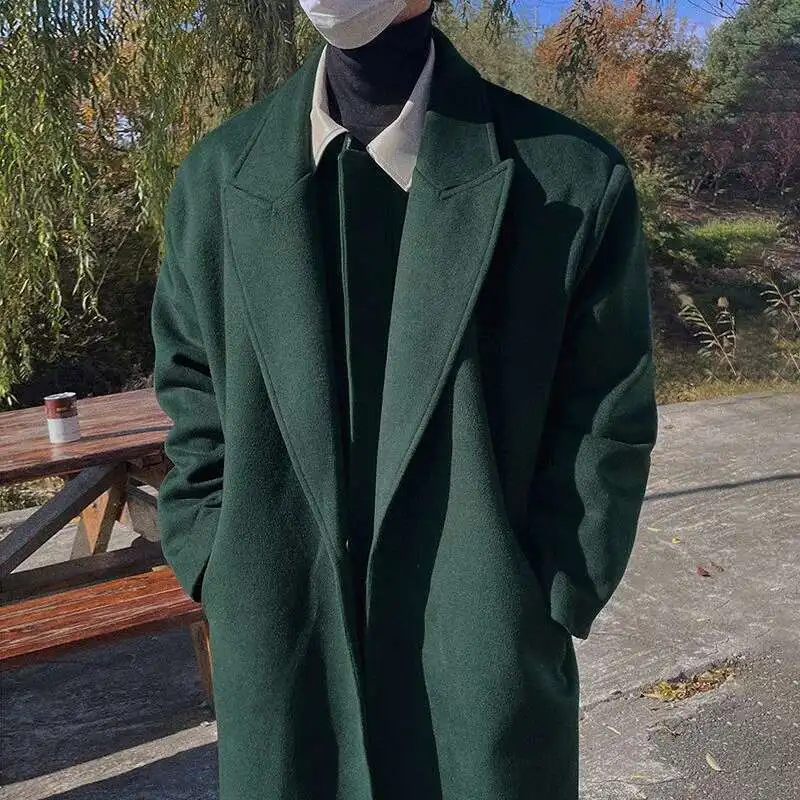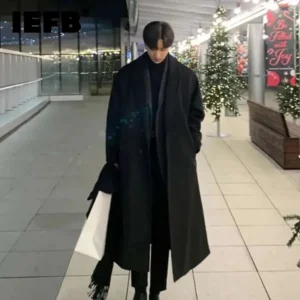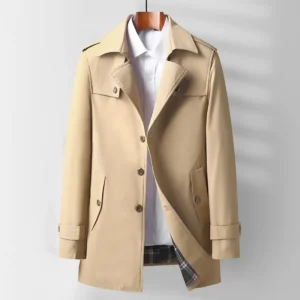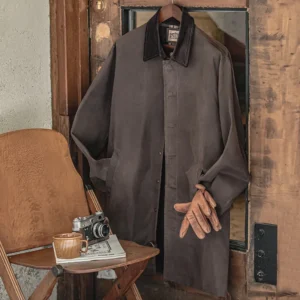Introduction: The Long Overcoat – Your Essential Winter Statement Piece
The long overcoat stands as the quintessential winter garment for the discerning man – a piece that extends below the knee, providing unmatched protection against the elements while simultaneously elevating your entire wardrobe. Unlike shorter outerwear options, a quality long overcoat delivers exceptional warmth by covering more of your body while creating a striking silhouette that has signified sophistication for generations.
Throughout fashion history, long overcoats have adorned the shoulders of gentlemen across various social strata, from military officers to business magnates. What makes this garment truly remarkable is its staying power – while cuts and details may evolve subtly, the fundamental appeal of a well-crafted long overcoat remains timeless. Understanding proper overcoat length creates the foundation for a winter wardrobe that balances practicality with refinement.
This comprehensive guide explores everything from material selection to styling options for different body types, helping you master the art of wearing this cold-weather essential. At Metro Cloak, our focus on premium men’s outerwear has taught us that the perfect long overcoat is both an investment and a statement, especially when you understand the principles of coat length that complement your frame and style preferences.
Selecting the Perfect Long Overcoat: Materials, Fit and Style
Before diving into styling options, it’s crucial to understand what makes a quality overcoat and how to find one that perfectly suits your needs. The foundation of any exceptional overcoat lies in three key elements: premium materials, proper fit, and timeless style.
Premium Materials for Maximum Warmth and Durability
The material of your overcoat determines not just its appearance but also its performance in winter conditions. When exploring mens long overcoat options, pay special attention to fabric composition:
Pure Wool (24-32 oz/680-907g): The classic choice offering excellent insulation, natural water resistance, and durability. Heavier weights (28+ oz) provide superior warmth for the coldest conditions.
Cashmere: Extraordinarily soft and lightweight yet offering up to three times more insulation than regular wool. Perfect for milder winter climates or for those who prefer lightweight luxury.
Wool Blends: Often mixed with synthetic fibers or cashmere to improve durability, reduce weight, or enhance softness. Quality blends maintain most of wool’s thermal properties while addressing specific performance needs.
Technical Fabrics: Modern overcoats sometimes incorporate water-resistant treatments or wind-blocking membranes while maintaining a classic appearance.
Understanding the differences between wool versus down overcoats helps you make better decisions based on your local climate and personal comfort preferences. Premium wool overcoats typically provide effective insulation down to about 25°F (-4°C), while technical fabrics or specially treated wool overcoats can perform well in even colder or wetter conditions.
Finding Your Perfect Fit: Length, Shoulders and Sleeve Proportions
An impeccably fitting overcoat should feel comfortable while projecting a clean, structured silhouette. Key fit considerations include:
Shoulder Alignment: The shoulder seam should align with your natural shoulder edge – neither extending beyond nor falling short of this point.
Length: A proper long overcoat typically falls anywhere from just below the knee to mid-calf. Your height largely determines the perfect coat length for your frame, but most men find that a hem hitting just below the knee creates the most versatile silhouette.
Sleeve Length: Ideally ends at your wrist bone, allowing about ¼ inch of suit jacket sleeve to show when worn over formal attire.
Chest and Waist: When buttoned, the coat should allow enough room for layering without excess fabric causing wrinkles. You should be able to comfortably cross your arms.
When trying on an overcoat, wear clothing similar to what you’ll typically layer underneath. A quality overcoat should feel substantial but not restrictive, with enough room for a suit or heavy sweater without appearing oversized.
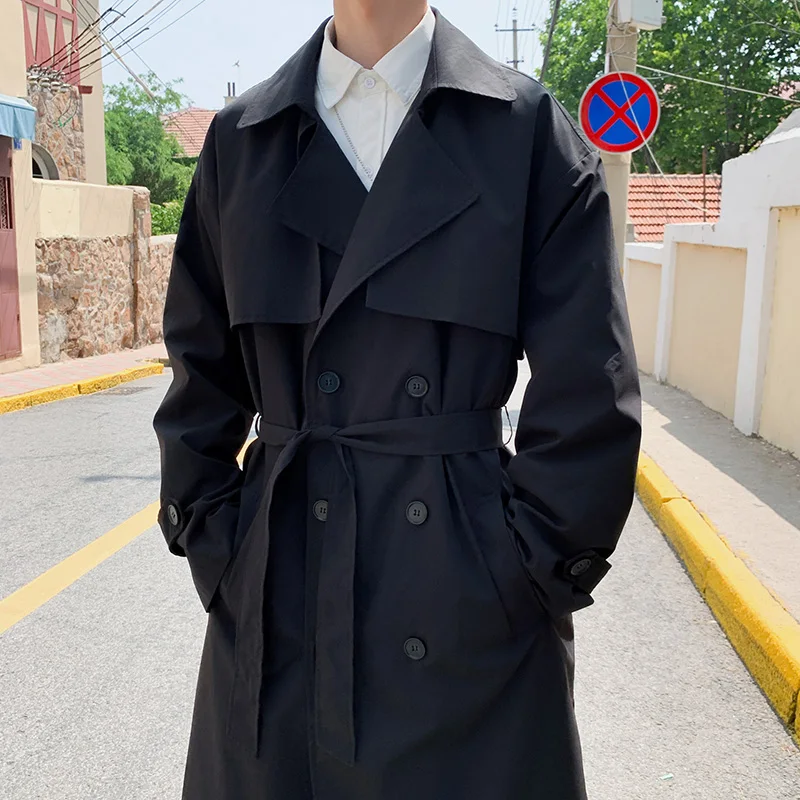
Classic vs. Contemporary Styles: Choosing What Works for You
Long overcoats come in several distinct styles, each with its own character and heritage:
Single-Breasted Overcoats: Clean, versatile silhouettes with a single column of buttons. Typically feature notched lapels and provide a more modern, streamlined look suitable for both formal and casual settings.
Double-Breasted Overcoats: More formal and dramatic, featuring overlapping front panels with two parallel columns of buttons. Our double-breasted overcoat collection showcases this classic style that provides superior warmth and wind protection.
Chesterfield: A single or double-breasted overcoat with a velvet collar, representing timeless elegance.
Guards Coat: Distinguished by its half-belt at the back, epaulets, and often a ticket pocket.
For maximum versatility, neutral colors deliver the most mileage:
– Navy and charcoal work seamlessly with business attire
– Camel and medium gray pair beautifully with both formal and casual outfits
– Black offers formal elegance but less daytime versatility
Consider your existing wardrobe when selecting a style and color – your overcoat should complement the majority of your winter clothing.
Mastering Overcoat Styling: From Business to Casual
The true versatility of a long overcoat reveals itself when you understand how to adapt it for different occasions. This essential garment transitions seamlessly from boardroom to weekend outings with the right styling approach.
Business and Formal Occasions: Refined Elegance
For business and formal settings, your overcoat becomes the crowning element of a polished appearance:
With Suits: Choose an overcoat that harmonizes with your suit color palette. A charcoal or navy overcoat creates a sophisticated pairing with most business suits. Ensure your coat is slightly longer than your suit jacket for a balanced proportion.
Color Coordination: Your formal dress coat should ideally be in the same color family as or slightly darker than your suit. For instance, a deep navy overcoat pairs wonderfully with navy, gray, or blue suits.
Formal Footwear: Complete the look with polished Oxford shoes or dress boots in black or dark brown, depending on your suit and overcoat colors.
Evening Formal Wear: For black tie events, a black or midnight blue overcoat creates an elegant outer layer over formalwear. Consider options with satin lapels for the most formal occasions.
Mastering formal coat and suit styling creates a powerful professional impression. When wearing your overcoat open, maintain a straight posture to allow the coat to hang properly, creating clean lines that enhance your overall silhouette.
Smart-Casual Settings: Versatile Sophistication
The long overcoat excels in smart-casual environments, where it adds refinement to more relaxed attire:
Elevated Business-Casual: Pair your overcoat with flannel trousers, a fine merino sweater, and a button-down shirt. This combination strikes the perfect balance between comfort and polish.
Textural Interest: Introduce visual depth by mixing textures – a smooth wool overcoat contrasts beautifully with a chunky knit sweater or textured trousers.
Footwear Options: Chelsea boots, quality leather loafers, or refined derby shoes complement the smart-casual overcoat look perfectly.
Color Play: Smart-casual settings allow for more color exploration. A camel overcoat pairs wonderfully with burgundy, forest green, or deep blue elements in your outfit.
For versatile smart-casual formulas, try:
– Overcoat + fine-gauge turtleneck + wool trousers + Chelsea boots
– Overcoat + button-down + V-neck sweater + chinos + loafers
The key to smart-casual styling lies in maintaining balance – the formality of the long overcoat is offset by the more relaxed nature of your other pieces.
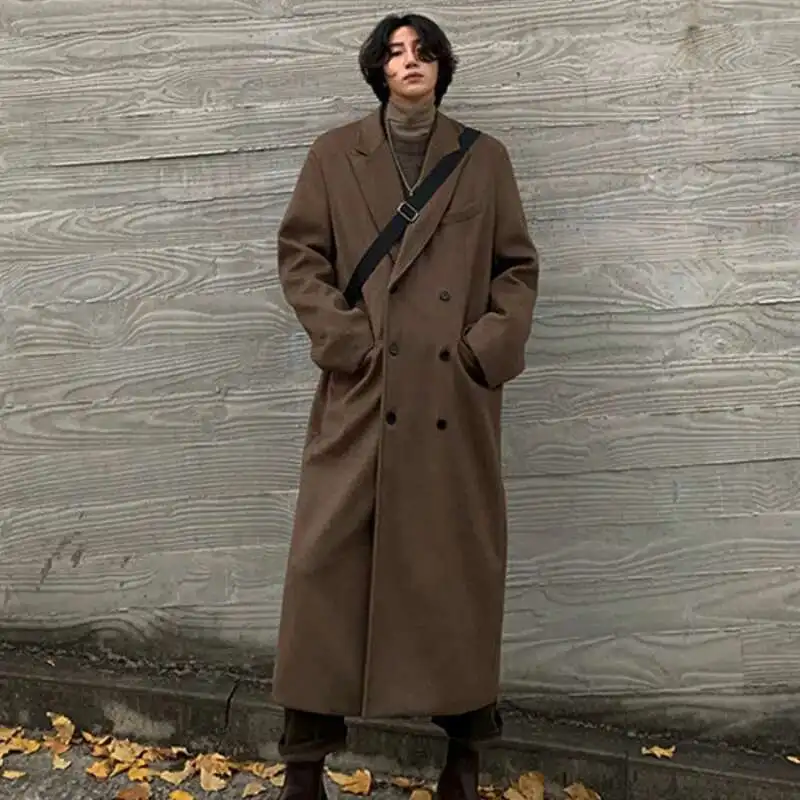
Weekend and Casual Wear: Understated Luxury
Contrary to common perception, long overcoats can look entirely appropriate in casual settings when styled thoughtfully:
Denim Pairings: Dark, well-fitted jeans create a handsome foundation for casual overcoat styling. Avoid distressed denim, which creates too stark a formality contrast.
Casual Knitwear: Crew neck sweaters, shawl-collar cardigans, or even sophisticated hoodies in solid colors work wonderfully under an overcoat for weekend wear.
Casual Footwear: Clean, minimalist sneakers in leather or suede, casual boots, or chukkas ground the look without undermining the coat’s refinement.
Relaxed Layering: A slightly looser fit in your casual layers creates a more relaxed impression while maintaining the overcoat’s elegant line.
Weekend outfit formulas to try:
– Camel overcoat + cashmere sweater + dark jeans + suede boots
– Gray overcoat + solid sweatshirt + chinos + leather sneakers
The secret to casual overcoat styling is confidence – wear it with the same ease as you would a more casual jacket, and the contrast between formal outerwear and casual components creates a compelling contemporary look.
The Art of Layering with Long Overcoats
Mastering layering techniques allows you to maximize both warmth and style with your long overcoat throughout the winter season.
Foundation Layering: Building from the Inside Out
Effective layering with overcoats follows a system that balances insulation with freedom of movement:
Base Layers: Start with light, fitted garments that manage moisture. Merino wool or quality cotton serves well for shirts and lightweight sweaters. These should fit close to the body without restricting movement.
Mid Layers: These provide primary insulation. Depending on temperature, options include:
- Lightweight option: Fine merino sweaters or vests
- Medium warmth: Cashmere sweaters or lightweight blazers
Maximum warmth: Chunky knits or lightweight down vests
Material Compatibility: Smoother fabrics layer best together, reducing friction and bunching. Reserve more textured pieces for your visible layers.
The best long overcoats for winter layering provide enough room for comfortable movement without excessive bulk. For temperatures below 20°F (-7°C), consider three distinct layers beneath your overcoat. Between 20-35°F (-7 to 2°C), two quality layers typically suffice.
Remember that effective layering doesn’t mean wearing your entire closet simultaneously – strategic material selection often provides more warmth than simply adding more layers.
Mastering Proportions: Balance and Visual Harmony
The key to sophisticated layering lies in maintaining balanced proportions:
Length Relationships: Inner layers should be progressively shorter as you move outward. For example, with a long overcoat, your suit jacket or blazer should be visible beneath the coat, and your shirt should extend just slightly beyond the jacket sleeve.
Visual Weight Distribution: Balance heavier visual elements throughout your outfit. If wearing a chunky sweater, keep other elements more streamlined to avoid appearing bulky.
Color Gradient: Consider a progression of colors from inner to outer layers. This creates depth and intentionality in your outfit.
Silhouette Management: Maintain a clean line from shoulders through the body of your coat. Avoid bulky items concentrated in one area, which can distort your silhouette.
Understanding the difference between short versus long coat proportions helps you create more visually harmonious outfits. A common proportion mistake is wearing too many heavy layers of similar lengths, creating a bulky, unrefined appearance.
Essential Accessories to Complement Your Overcoat
The right accessories not only enhance warmth but also personalize your overcoat style, creating a complete winter look.
Scarves and Neckwear: Adding Warmth and Visual Interest
A well-chosen scarf transforms your overcoat ensemble while providing crucial neck protection:
Materials: Cashmere offers unmatched softness and warmth with minimal bulk. Wool provides excellent insulation at a more accessible price point. Silk scarves can work for milder days or formal evening events.
Styling Techniques:
- The Parisian Knot: Fold scarf in half, drape around neck, then pull ends through the loop for a secure, elegant look.
- The Once Around: Simply wrap around your neck once, letting ends hang down evenly in front.
The Draped Style: For milder days or a more relaxed look, simply drape the scarf over your shoulders under the coat collar.
Color Selection: Your scarf offers an excellent opportunity to introduce color. Consider complementary colors to your overcoat (navy coat + burgundy scarf) or create monochromatic sophistication with tonal variations (charcoal coat + lighter gray scarf).
For formal settings, finer weaves and subdued patterns work best. For casual outings, embrace bolder colors and chunkier knits to add character to your ensemble.
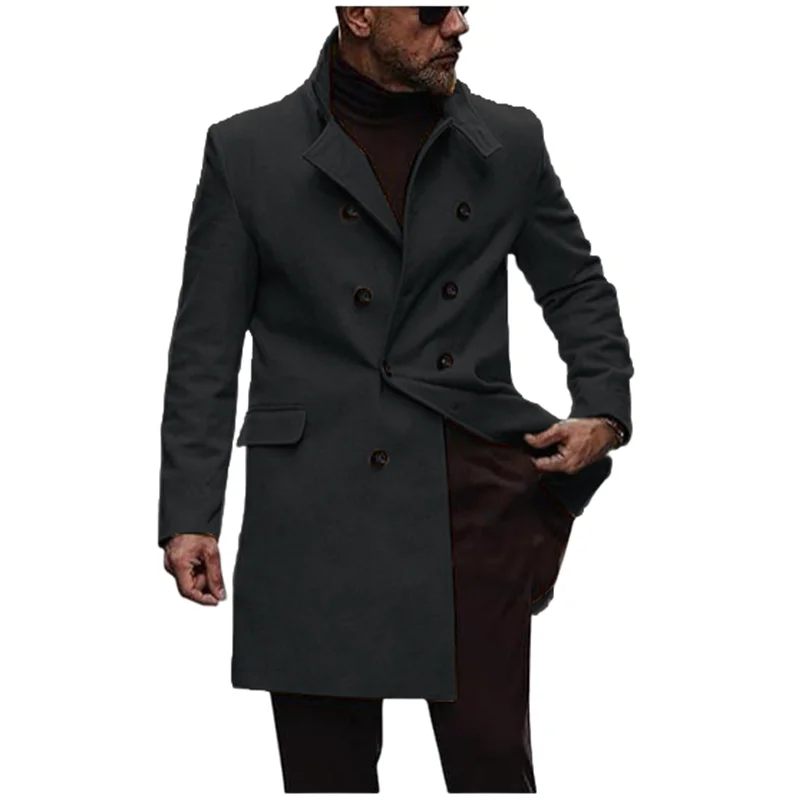
Gloves and Headwear: Functional Elegance
Proper hand and head protection completes your winter arsenal:
Gloves: Leather gloves in black, brown, or navy represent the most versatile option. For maximum warmth, look for cashmere-lined varieties. Suede offers a more casual texture, while smooth leather appears more formal. Ensure your gloves fit snugly without restricting finger movement.
Headwear Options:
- Wool fedoras or trilbies pair beautifully with formal overcoats
- Flat caps offer a smart-casual option with heritage appeal
- Fine-knit beanies in coordinating colors provide a modern, casual alternative
Classic wool watch caps work well with more casual styling
Material Coordination: For a cohesive look, echo materials throughout your accessories – leather gloves that complement your shoes, wool caps that harmonize with your scarf.
When selecting headwear, consider face shape: wider-brimmed hats generally complement narrower faces, while more compact styles suit broader face shapes.
Mens Cashmere Overcoat, Mens Hooded Winter Coat, Mens Wool Blend Coat
Price range: $128.72 through $139.68 Select options This product has multiple variants. The options may be chosen on the product pageMens Black Overcoat, Mens Black Wool Coat, Mens Wool Overcoat
$339.18 Select options This product has multiple variants. The options may be chosen on the product pageMens Grey Overcoat, Mens Wool Blend Coat, Mens Wool Overcoat
$201.28 Select options This product has multiple variants. The options may be chosen on the product pageMens Herringbone Coat, Mens Long Overcoat, Mens Wool Overcoat
Price range: $197.16 through $203.69 Select options This product has multiple variants. The options may be chosen on the product pageMens Long Overcoat, Mens Topcoats
Price range: $189.40 through $196.88 Select options This product has multiple variants. The options may be chosen on the product pageMens Long Overcoat, Mens Tweed Coat
Price range: $397.49 through $409.96 Select options This product has multiple variants. The options may be chosen on the product page
Footwear: Completing the Look from Ground Up
Appropriate footwear anchors your overcoat ensemble and provides necessary winter functionality:
Formal Settings: Oxford shoes in black or dark brown leather offer timeless elegance. For inclement weather, consider dress boots with Goodyear welted construction for water resistance.
Smart-Casual Pairings: Chelsea boots, brogue boots, or derby shoes strike the perfect balance between refinement and practicality.
Casual Combinations: Quality leather sneakers, chukka boots, or work-inspired boots complement casual overcoat styling.
Weather Considerations: For snowy conditions, seek boots with rubber soles offering traction. Consider applying protective treatments to leather footwear before winter to prevent salt and water damage.
Color coordination between your overcoat and footwear creates visual coherence – black footwear pairs naturally with charcoal, black, or navy overcoats, while brown shoes harmonize beautifully with camel, tan, or brown coats.
Body Type Considerations for Long Overcoats
Finding the most flattering overcoat for your physique enhances both comfort and appearance.
For Tall Men (6‘0”/183cm and above):
– Longer overcoats (below knee) create balanced proportions
– Double-breasted styles particularly flatter taller frames
– Horizontal details like belts can break up height effectively
– Our specialized advice for long overcoats for tall men provides additional considerations
For Shorter Men (under 5‘8”/173cm):
– Choose shorter overcoat styles (just covering the knee)
– Single-breasted designs with minimal details reduce visual bulk
– Vertical elements like a narrow lapel create lengthening effects
– Proper coat length for every body type is crucial for proportion
For Athletic/Broad Builds:
– Ensure comfortable fit across shoulders without excess material
– Single-breasted styles with structured shoulders maintain clean lines
– Avoid excessively slim cuts that may restrict movement
– Consider made-to-measure options for ideal fit
For Larger Frames:
– Structured shoulders create a defined silhouette
– Single-breasted styles with longer lapels create a lengthening effect
– Dark, solid colors offer a sleek appearance
– Avoid bulky details or excessive pattern
Remember that minor tailoring adjustments can dramatically improve how an overcoat fits your unique physique. Sleeve length, button placement, and even subtle waist suppression can transform an off-the-rack coat into one that appears custom-made.
Care and Maintenance for Longevity
Quality overcoats represent a significant investment – proper care ensures years of service and sustained elegance.
Routine Care:
– Brush your coat regularly with a clothes brush to remove surface dirt and debris
– Allow your overcoat to air out for 24 hours after wearing before storing
– Use wide, structured hangers to maintain shoulder shape
– Spot clean minor stains promptly with appropriate cleaning solutions
Material-Specific Care:
– Wool: Professional dry clean only, typically once per season unless soiled
– Cashmere: Cashmere overcoats require gentle handling – professional cleaning recommended, protect from moths during storage
– Blends: Follow care instructions for the predominant fiber
Seasonal Storage:
– Clean your coat before storing for the off-season
– Use breathable garment bags rather than plastic
– Include cedar elements to deter moths
– Store in a cool, dry location away from direct sunlight
– Consider professional cold storage for valuable cashmere pieces
Maintenance Schedule:
– Beginning of season: Inspect for needed repairs, refresh with steaming if needed
– Mid-season: Button reinforcement check, spot cleaning as needed
– End of season: Professional cleaning, repair assessment before storage
Simple preventive measures like avoiding prolonged exposure to rain or snow and addressing minor damage promptly will significantly extend your overcoat’s lifespan.
Expert Style Tips and Common Mistakes to Avoid
Fine-tune your overcoat style with these professional insights:
Expert Styling Techniques:
– Leave the bottom button undone on single-breasted styles for a relaxed, traditional look
– Pop the collar in inclement weather – it’s both functional and stylish
– Consider a half-buttoned approach for ease of movement while maintaining a clean line
– Master the art of the “collar and lapel break” – how your coat collar sits relative to your suit lapel
Common Mistakes to Avoid:
– Overstuffed pockets that distort the coat’s clean lines
– Improper length that throws off overall proportions
– Wearing styles too formal or casual for the setting
– Neglecting proper layering, resulting in restricted movement
– Allowing the coat to become visibly wrinkled or creased
Modern Styling Approaches:
– Belt your overcoat occasionally for a contemporary silhouette
– Experiment with unexpected color combinations in accessories
– Mix traditional and contemporary elements for a personalized look
– Consider turning up the cuffs slightly to reveal a hint of texture or color
The most sophisticated overcoat wearers understand that minor adjustments – how the collar sits, the way it drapes when unbuttoned, the interplay with accessories – create the difference between merely wearing an overcoat and truly mastering it.
Supplemental Content: Addressing Common Questions
Is a long overcoat too formal for casual settings?
Not necessarily. While long overcoats have formal origins, contemporary styling with casual elements like jeans, knitwear, and minimalist sneakers creates a balanced look appropriate for many casual settings. The key is in the styling approach.
What classifies as a premium overcoat?
Premium overcoats typically feature high-quality natural materials (pure wool, cashmere), superior construction (hand-stitched elements, canvas interlining rather than fused), thoughtful details (functioning buttonholes, quality buttons), and excellent fit. These elements justify the investment through longevity and superior performance.
How does a long overcoat compare to a shorter coat for warmth?
Long overcoats generally provide superior warmth by covering more of the body, particularly the legs. This additional coverage becomes especially valuable in windy conditions or when spending extended time outdoors. However, proper winter coat length should also consider your lifestyle – shorter coats offer more freedom of movement for active wearers.
What are the essential overcoat styles every man should consider?
For maximum versatility, consider these foundation styles:
1. A single-breasted wool overcoat in navy or charcoal for business settings
2. A camel hair or wool overcoat for smart-casual versatility
3. A textured option (herringbone or tweed) for weekend wear
Final Thoughts: Investing in Timeless Style
The long overcoat represents more than just winter protection – it’s a statement of personal style that transcends seasonal trends. When viewed through the lens of cost-per-wear, a quality overcoat might be among the most economical investments in your wardrobe, potentially providing 10-15 years of service when properly maintained.
What distinguishes the overcoat from other winter garments is its remarkable adaptability. Few pieces transition so seamlessly from protecting a tuxedo at a formal event to complementing jeans and a sweater for weekend outings. This versatility, combined with the undeniable presence a well-fitted overcoat creates, makes it an essential element in the sophisticated man’s arsenal.
As you develop your personal style, remember that overcoat traditions provide valuable guidelines, but they shouldn’t restrict personal expression. The most compelling overcoat style comes from understanding fundamental principles while adapting them to suit your unique preferences and lifestyle.

